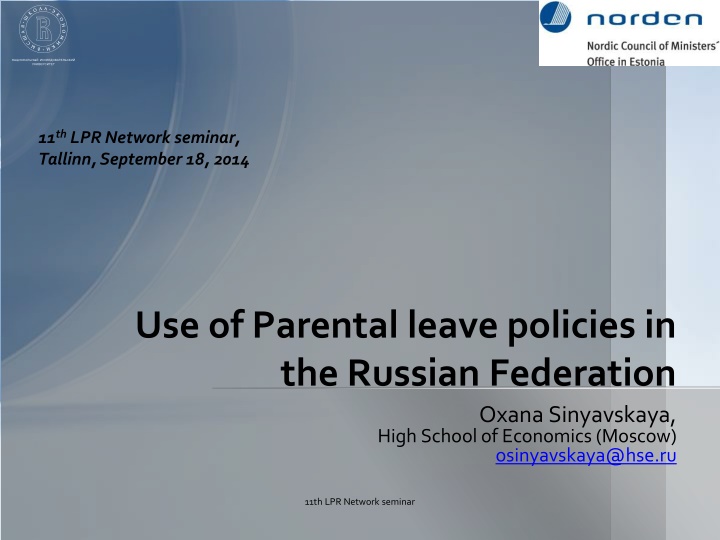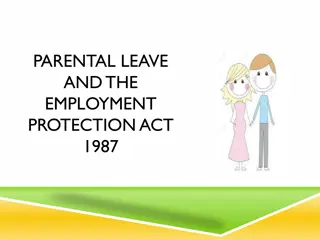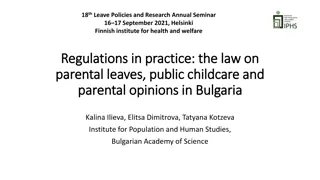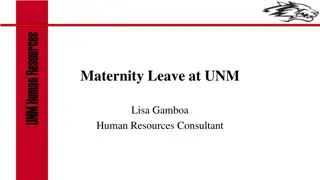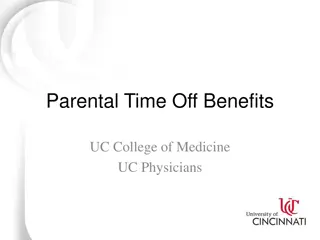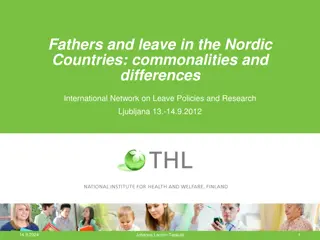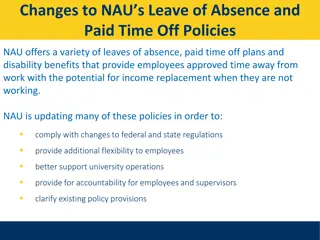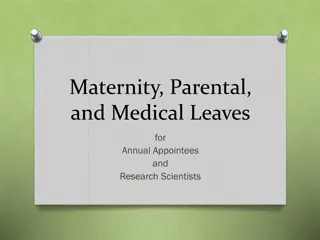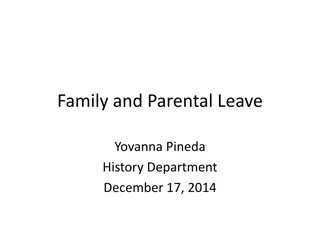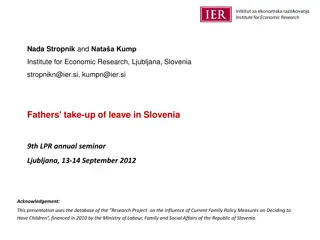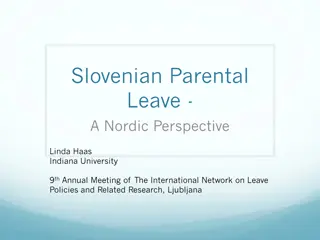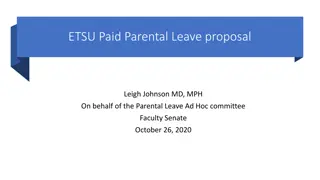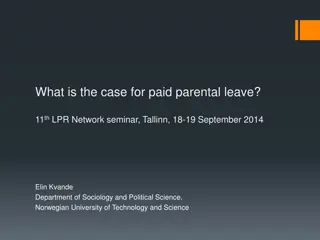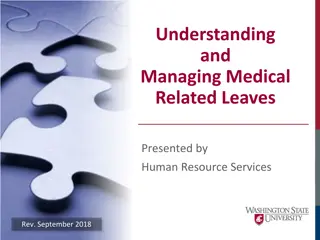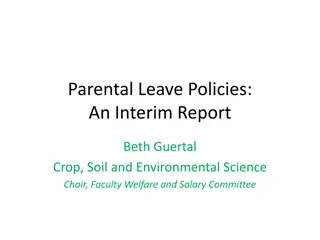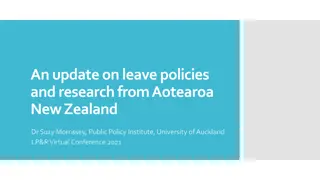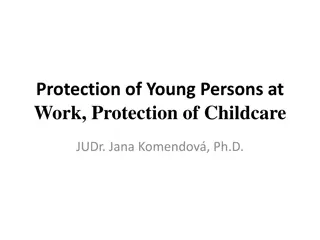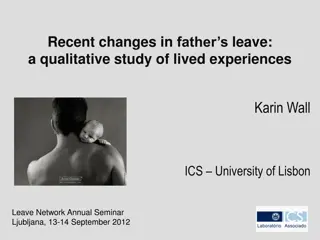Understanding Parental Leave Policies in Russia
Explore the utilization of parental leave policies in the Russian Federation, focusing on minimum and maximum benefits, formal childcare coverage, average monthly benefits, and challenges with data reliability and availability.
Download Presentation

Please find below an Image/Link to download the presentation.
The content on the website is provided AS IS for your information and personal use only. It may not be sold, licensed, or shared on other websites without obtaining consent from the author.If you encounter any issues during the download, it is possible that the publisher has removed the file from their server.
You are allowed to download the files provided on this website for personal or commercial use, subject to the condition that they are used lawfully. All files are the property of their respective owners.
The content on the website is provided AS IS for your information and personal use only. It may not be sold, licensed, or shared on other websites without obtaining consent from the author.
E N D
Presentation Transcript
11th LPR Network seminar, Tallinn, September 18, 2014 Use of Parental leave policies in the Russian Federation Oxana Sinyavskaya, High School of Economics (Moscow) osinyavskaya@hse.ru 11th LPR Network seminar
Maternity and parental leaves in Russia Minimum differentiated by birth order 2007+ 100% wage 40% wage Paid Parental leave Unpaid Parental leave Maternity leave 10 weeks 10 weeks Child 1.5 years old Child 3 years old Childbirth Extended to not employed women from 2007 11th LPR Network seminar
Formal childcare coverage by childs age Coverage of children by preschool institutions 9kindergartens) 100 90 80 Unpaid leave 70 60 Paid leave 50 40 30 20 10 0 0 1 2 3 4 5 6 urban rural 11th LPR Network seminar 2010 Census data
Minimum and maximum parental leave benefits as a percentage of average wage and children subsistence minimum 90 84.8 70 % of average wage 66 77.6 77.2 77.1 80 76.6 60 59 71.6 70.1 55 53 70 50 % of child subsistence minimum 60 44 40 3840 50 42.4 30 38.8 38.6 38.6 38.3 40 35.8 35 20 30 10 20 6 0 10 0 2007 2008 2009 2010 2011 2012 2013 min 1st child min 2nd child max for the 1st child for the 2nd+ child 11th LPR Network seminar Rosstat data
Average monthly benefits to care for children below 18 months, 2012 In % to children subsistence minimum In % to average wage Average size of monthly benefits for care for a child under 18 months RUB EURO to insured women (paid parental leave benefits) for the 1st child 6092 148.6 97.3 22.9 for the 2nd+ child 6477 158.0 103.5 24.3 to not insured women for the 1st child 2326 56.7 37.2 8.7 for the 2nd+ child 4652 113.5 74.3 17.5 Social Insurance Fund data 11th LPR Network seminar
Use of leaves data problems Very limited statistical information Social Insurance Fund data are not often reliable A small number of observations in a limited number of sociological surveys Russian Generations and Gender Survey, wave 3, 2011 (N=11,174) Sample of female respondents 17-44 years old with biological and adopted children from 0 to 35 months in the household (N=374) Examples from other data (source is indicated) 11th LPR Network seminar
Duration of leave after the 1st birth 1965-1990 1991-2005 35 30 Per cent of all women who had one child 25 20 15 10 5 0 none 0-3 months 4-12 months 13-18 months 19-36 months 36+ months EES 2005 11th LPR Network seminar
Number of monthly benefits for care for a child under 18 months 2009 2010 2011 2012 Number of births 1 761 687 1 788 948 1 796 629 1 902 084 Number of lump-sum birth grants paid: 1 579 007 1 678 957 1 731 188 1 157 920 1 248 041 1 277 993 incl.: to employed women 421 087 430 916 453 195 to not employed women Number of monthly benefits for care for a child under 18 months: 3 629 560 3 823 090 3 870 726 incl.: to insured women (paid parental leave benefits) 1 107 662 1 180 634 1 167 794 for the 1st child 925 811 1 041 967 1 107 852 for the 2nd+ child 1 595 080 to not insured women 820 018 789 014 for the 1st child 776 069 811 475 for the 2nd+ child 11th LPR Network seminar Rosstat data, based on SIF
Proportion of paid parental leaves in total number of benefits for care for a child under 18 months 61 60 59 58 57 1st child 56 59.9 2nd+ child 55 57.5 54 56.2 53 54.4 52 51 2,010 2,011 11th LPR Network seminar Author s calculation based on Rosstatdata, based on SIF
Potential availability of certain statutory arrangements related to childbirth, by type of contract, 2007-2011 Does your job provide access to ? Statutory arrangements Type of contract maternity leave parental leave both sick leaves 85.3 82.5 82.3 86.5 Employees, - by the type of contract: 91.9 88.9 88.7 92.8 permanent labor contracts 73.5 70.1 69.3 74.6 temporary labor contract or subcontract 19.6 20.3 19.6 24.1 verbal agreement - by firm ownership: 71.8 67.7 67.2 73.6 Private firm / person 98.4 97.1 97.0 98.9 Public 95.4 91.2 91.2 95.4 Mixed Total 81.1 78.4 78.2 82.2 GGS 2007-2011 (from: Sinyavskaya, Billingsley 2014) 11th LPR Network seminar
Female activity status by the age of the youngest child, 2011 46.0 28.0 24-35 Age of the youngest child, months 17.1 55.3 18-23 student employed 7.4 67.9 12-17 on leave unemploye OLF 9.7 72.6 6-11 1.8 67.3 0-5 0% 10% 20% 30% 40% 50% 60% 70% 80% 90% 100% 11th LPR Network seminar GGS, 2011
Proportion of women reported being on leave or receiving leave benefits by the age of the youngest child, 2011 90 78.3 80 70 57.5 60 47.5 50 41.4 % 0-18 40 32.6 0-36 30 23.5 20 14.6 9.6 10 0 On maternity leave On paid parental leave Got maternity leave Got parental leave benefits during last 12 months benefits during last 12 months 11th LPR Network seminar GGS, 2011
Conclusions Coverage almost universal (at the expense of extending coverageto not employed) The biggest problem level of compensation Potential availability of parental leaves no effect on fertility intentions (due to the size?) (Sinyavskaya, Billingsley 2011) However, using of leaves (not too long) has positive effect on both subsequent fertility and return to employment (Gerber, Perelli-Harris 2012) 11th LPR Network seminar
